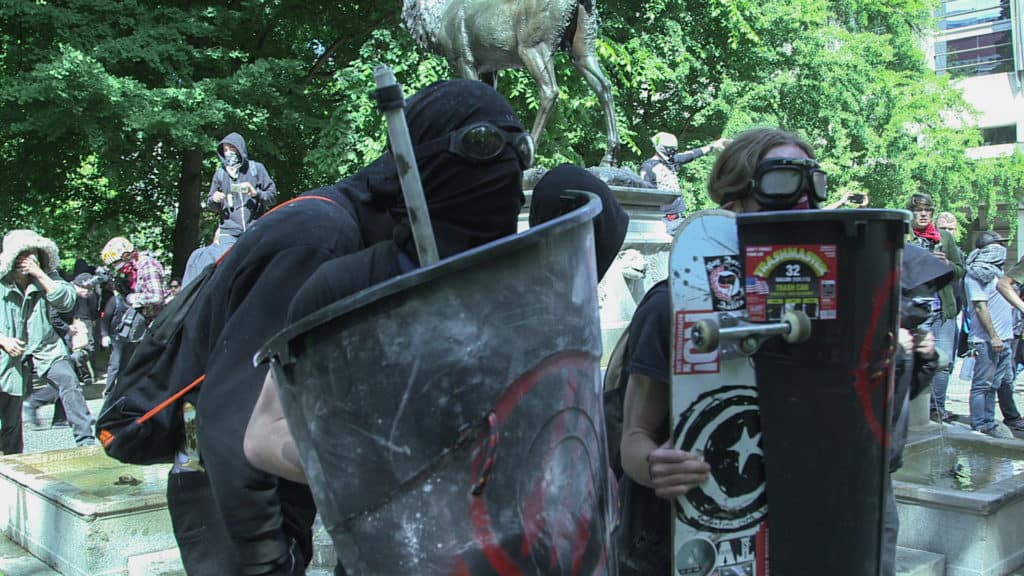The Case Against Antifa
German Lopez, Vox, August 29, 2017

Antifa prepare to face off with Trump supporters during a free speech rally at Terry Schrunk Plaza in Portland, Oregon, on June 4, 2017. (Credit Image: © Emily Molli/NurPhoto via ZUMA Press)
Over the weekend, activists descended on Berkeley, California, and attacked peaceful protesters. But it wasn’t far-right white supremacists leading the violence this time, as was the case in Charlottesville, Virginia, a few weeks ago. It was left-wing “antifa” (short for “anti-fascist”) counterprotesters who assaulted people.
{snip}
The argument for antifa activists is that the current crop of right-wing protesters — which are partly but not entirely made up of neo-Nazis, KKK members, and other white supremacists and nationalists — are so extreme that they must be stopped swiftly and even violently.
{snip}
What this view misses is the backlash that may come from political violence: that such violence can reinforce right-wing views about the left. As Michael Kazin, a history professor at Georgetown University and editor of Dissent magazine, told me earlier this year, “[N]on-leftists often see [the left] as a disruptive, lawless force. Violence tends to confirm that view.”
Antifa’s violence plays into Trump’s hands
Some of this backlash is already happening. Consider how Trump himself reacted to Charlottesville. He drew a lot of (justified) criticism for arguing that “both sides” had been behind the violence in Charlottesville, instead of pinning the blame on the white supremacists who swarmed the Virginia city and caused mayhem.
But one reason Trump could draw up this false equivalence in the first place is because antifa protesters have been carrying out violence against right-wing groups for months now. As Peter Beinart reported in the Atlantic, antifa activists have violently protested right-wing speakers like Milo Yiannopoulos and conservative political scientist Charles Murray. In the Yiannopoulos protests in particular, antifa activists even threw explosive Molotov cocktails and other objects at police.
When far-left protesters act violently, it gives Trump and other conservatives more ammunition to draw equivalencies between the far left and far right — even if it is a false equivalence, given that America has a long history of racist violence and very little, by comparison, of left-wing violence.
And this argument seems to be working for a lot of people. A poll earlier this month by SurveyMonkey found that while 46 percent of US adults said far-right protesters were mostly to blame for the violence in Charlottesville, 40 percent agreed that the blame fell equally on both sides and another 9 percent blamed counterprotesters.
{snip}
This wouldn’t be the first time violence has led to a conservative backlash in the US.
During the 1960s, there were hundreds of riots across America in protest of police brutality and in support of civil rights. Experts say the riots were a major contributor to the rise of “law and order” and “tough on crime” policies that followed in the coming decades. These policies made police more aggressive and filled America’s prisons to levels never seen before in US history. In short, the perception of lawlessness led both Americans and their politicians to demand more stringent law enforcement.
{snip}
Trump himself ran on a “law and order” and “tough on crime” platform. If Trump can credibly argue that there is a lot of chaos and violence out there, that could empower him to carry out a crackdown. And with that crackdown could come both greater support for Trump and the enactment of his policies. It’s an outcome that antifa doesn’t want — but antifa’s approach to protest could very well fuel it.
{snip}















